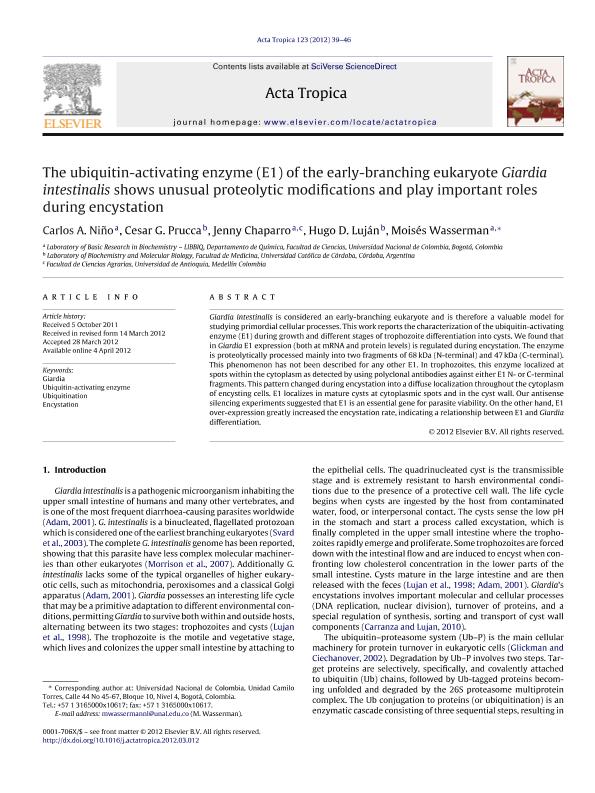Artículo
The ubiquitin-activating enzyme (E1) of the early-branching eukaryote Giardia intestinalis shows unusual proteolytic modifications and play important roles during encystation
Fecha de publicación:
07/2012
Editorial:
Elsevier Science
Revista:
Acta Tropica
ISSN:
0001-706X
Idioma:
Inglés
Tipo de recurso:
Artículo publicado
Clasificación temática:
Resumen
Giardia intestinalis is considered an early-branching eukaryote and is therefore a valuable model for studying primordial cellular processes. This work reports the characterization of the ubiquitin-activating enzyme (E1) during growth and different stages of trophozoite differentiation into cysts. We found that in Giardia E1 expression (both at mRNA and protein levels) is regulated during encystation. The enzyme is proteolytically processed mainly into two fragments of 68. kDa (N-terminal) and 47. kDa (C-terminal). This phenomenon has not been described for any other E1. In trophozoites, this enzyme localized at spots within the cytoplasm as detected by using polyclonal antibodies against either E1 N- or C-terminal fragments. This pattern changed during encystation into a diffuse localization throughout the cytoplasm of encysting cells. E1 localizes in mature cysts at cytoplasmic spots and in the cyst wall. Our antisense silencing experiments suggested that E1 is an essential gene for parasite viability. On the other hand, E1 over-expression greatly increased the encystation rate, indicating a relationship between E1 and Giardia differentiation. © 2012 Elsevier B.V.
Palabras clave:
ENCYSTATION
,
GIARDIA
,
UBIQUITIN-ACTIVATING ENZYME
,
UBIQUITINATION
Archivos asociados
Licencia
Identificadores
Colecciones
Articulos(CIQUIBIC)
Articulos de CENTRO DE INVEST.EN QCA.BIOL.DE CORDOBA (P)
Articulos de CENTRO DE INVEST.EN QCA.BIOL.DE CORDOBA (P)
Citación
Niño, Carlos A.; Prucca, Cesar German; Chaparro, Jenny; Lujan, Hugo Daniel; Wasserman, Moisés; The ubiquitin-activating enzyme (E1) of the early-branching eukaryote Giardia intestinalis shows unusual proteolytic modifications and play important roles during encystation; Elsevier Science; Acta Tropica; 123; 1; 7-2012; 39-46
Compartir
Altmétricas




